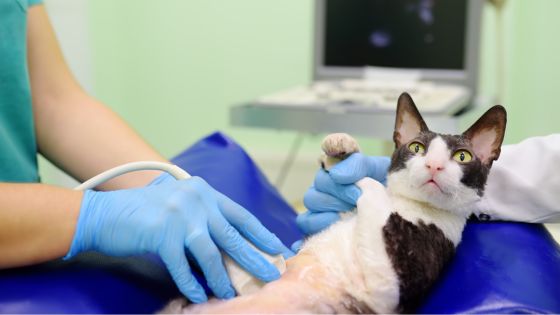Oftentimes, pet owners overlook injuries that can be life-threatening. Injuries can range from skin lacerations, bleeding wounds, and bites to less obvious injuries like internal damage or neurological damage from being picked up and shaken by another dog (small dogs are particularly prone to this).
Check your pet frequently for any signs of trauma, especially surface cuts that should be cleaned with an iodine solution followed by an antibiotic ointment. Deeper gashes should be firmly compressed to control bleeding.
Strains & Sprains
Many pets enjoy a healthy level of exercise and can even be considered athletes – but their bodies may not always be prepared for the demands they place on their joints and muscles. “Sprains” damage the ligaments that connect bones, which can happen if a pet jumps or falls over the couch or steps into a hole while on a walk. The knee and wrist are common joints that can sprain, while the hip and thigh can also be susceptible to strains.
These injuries can be prevented by ensuring that pets are leashed or otherwise under control when outside and by keeping bushes and other plants with thorns, sticks, and glass out of their reach. For more serious injuries, like bone fractures, it’s best to keep your dog or cat still until a vet can see them – moving can make the injury worse.
Fractures typically occur from trauma, such as being hit by a car or falling from a height. These can also cause internal bleeding – so pets should be stabilized and possibly placed in splints made of towels, magazines, or other stiff materials until a vet can see them.
Bruises are common for pets that run through bushes with thorns, step on glass or other sharp objects while out on walks, and can also result from rough play. The good news is that these bruises generally go away on their own in a few days. To help them heal, you can use ice packs or heating pads (as long as you check with your veterinarian first to make sure you’re not giving your pet drugs that could be toxic in dogs or cats). Rest also helps. Crate your pet if they’re reluctant to stay still, and consider using a harness or crate wrap so they can’t move too much while confined.
Choking on foreign objects is more difficult to prevent, but you can limit their exposure by removing unsafe items such as household chemicals and sharp tools, making sure rubbish is inaccessible, and not leaving food scraps lying around where pets can access them. You can also monitor your pet for gastrointestinal symptoms, such as vomiting or diarrhea, which are signs that something they’ve eaten is irritating or even poisonous.
Broken or Torn Nails
A broken nail is a common injury, and it can be a serious one if left untreated. If your dog’s nail is bleeding or is ripped completely off, you should seek veterinary attention immediately. Depending on the severity of the break, your dog may need to be sedated or put under mild sedation in order for the vet to clean the area and remove the nail fragment if necessary. It is also possible for the vet to cauterize the area around the nail quickly to stop excess bleeding. The vet will then bandage the paw and usually prescribe some pain medication and antibiotics to prevent infection and promote healing. A cone will be recommended to prevent your dog from licking at the wound, which can lead to further complications.
Minor nail breaks that are not bleeding may be able to be treated at home, but you will need to gently wrap your dog’s foot in a light bandage. It is important to restrain your dog properly if they are trying to move around while you are looking at the paw – this can be difficult, especially for dogs that wriggle a lot. It is often best to have someone else hold the dog while you check the paw, as they may bite if they are in pain.
If the nail is bleeding a lot, you can attempt to stop the blood flow by applying pressure with a paper towel or gauze. You can also use a styptic pencil or powder (usually found in the first aid section of your drug store) on the nail to help with this. A tourniquet should never be used to stop a nail from bleeding, as this can do more harm than good.
Your veterinarian will be able to tell you if the nail is broken and needs to be removed or just cracked and needs to be filed down or if the nail simply needs to be bandaged and allowed to heal on its own. In some cases, the veterinarian may need to sedate your pet, remove the nail if it is very large or severely broken, clean the surrounding area, and apply a fresh bandage before sending you home with antibiotics to prevent infection and reduce inflammation.
Wounds & Bites
Injuries such as cuts and scrapes, burns from contact with hot surfaces and abrasive objects, or crushed ribs can occur in dogs and cats. Injuries resulting from a fight with another animal or from an attack by a human are also common.
These injuries are often not immediately apparent. A frightened or hurt pet will hide its pain in order to survive and is unlikely to reveal the extent of its injury unless it is touched or moved. Consequently, these patients need to be handled gently and carefully, with a high index of suspicion for hidden injuries such as crushed or broken bones, ripped or ruptured lungs (due to rib fractures or sternal dislocation), lacerated trachea, lacerated ovaries, uterine prolapse, or internal organ damage.
It is essential to keep these patients as calm as possible during transport to the hospital to prevent further trauma or bleeding. It may be necessary to administer a sedative or anesthetic in these cases. The veterinarian will then shave the fur around the wound to reduce the risk of infection, flush the wounds to remove contaminants and debris, and determine if antibiotics are needed.
Many bites are minor and heal well with home care. However, some require veterinary attention, such as deep puncture wounds or those that involve bones or joints. Antibiotics are generally required in these wounds to prevent infection. The most common bacteria associated with dog bite wounds are Pasteurella species. Cat bites usually produce a mixed aerobic and anaerobic infection.
Some injuries, such as a slipped disc in small dogs with long backs, such as dachshunds and corgis, can be very serious and even fatal. To prevent this, these pets should not be allowed to jump up or down from furniture and should be transported with as little movement as possible.
Pets should always be kept on a leash when outside the house. This can help prevent them from running into or tripping over things and getting injured. Pets should not be allowed to climb or leap over things such as high fences, counters, or chairs because they could fall and injure themselves.
Injuries Associated with Pregnancy
Pets undergo many physical changes during pregnancy, similar to their human owners. However, while most pregnancies and deliveries go smoothly, some complications can be dangerous for pets and humans alike.
Soft tissue injuries, such as bruises and strains, can occur in any dog during strenuous exercise or just by bumping into a hard object. According to a study published in the journal Veterinary and Comparative Orthopedics and Traumatology, this type of injury is more common in dogs that participate in agility training. Thirty-three percent of agility participants experienced soft tissue injuries during their training, primarily affecting the back or shoulder areas.
Injuries can also occur while running or jumping, especially if your pet catches its nail on something. This can cause the nail to bleed, and it is important to treat this quickly to avoid infection. Using a styptic pencil or putting flour on the nail can stop the bleeding. Contact your vet if the nail is still bleeding or the blood doesn’t stop after using these methods.
Reptiles and amphibians may carry venomous parasites or bacteria that can be passed on to humans. Keeping these pets away from areas where food is stored or prepared, and keeping children and babies away from them, can help reduce the risk of catching one of these diseases. It’s also important to keep these pets up to date on regular vet check-ups to help prevent any potential health problems.




















